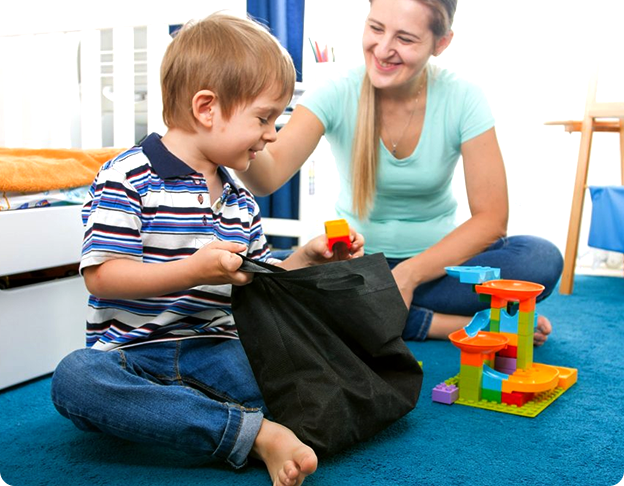Children with autism often exhibit behaviors that parents, teachers, siblings and caretakers find challenging. Many of these behaviors are related to the fact that the child frequently finds everyone and everything challenging and frustrating. When discussing behaviors exhibited by kids with autism, it is important to remember that these behaviors may have overlapping causes and triggers. It is also important to recognize that the child’s age and level of support needed can impact behavior, so not every child will display the same behaviors to the same degree. Therefore, methods that have worked for other parents and caregivers may not be effective for your son or daughter. However, the principles of applied behavior analysis therapy have proven successful for helping children with autism cope with the challenges of the outside world, so many of the suggestions for adults dealing with challenging behaviors have at least some basis in these principles.
Examples of Challenging Behaviors in Early Childhood and Suggestions for Dealing With Them
1 Insistence on routine is a common behavior in both children and adults with ASD. The route taken between home and school must be the same every day, toys must be lined up in the same order, the same sequence of actions must be followed at bath time, or sandwiches must always be sliced to create four triangles, left intact, or cut into two rectangles and so on. Any disruption could result in a meltdown or shutdown. Whenever possible, prepare your child for an alteration in routine. For example, if you plan to take your child shopping for new shoes immediately after picking him or her up from school, discuss the deviation in route ahead of time, preferably on a daily basis for several days. Explain why the change is needed and the benefit your child will receive from the deviation. If your child responds well to visual representations, prepare a pictorial display that shows the school, the route to the store and images of new shoes. For issues such as the arrangement of toys, try to pique his or her curiosity by asking what would happen if he or she tried making a minor change. This gives your child a chance to tell you if there is some underlying fear that something bad would happen as a result of the change.
2 There may be other triggers to the challenges displayed, hypersensitivity as well as a marked lack of sensitivity. Other factors that contribute to the overload can relate to touch, sound, sight, taste or smell as well as the vestibular and proprioceptive senses. The proprioceptive sense refers to knowing what the joints and muscles are doing as well as to the individual’s perception of his or her position in a space. The vestibular sense is related to the awareness of balance, head position and movement. Children with autism frequently perceive things differently to sound or touch. They may be frightened by a loud noise, or they may be so unresponsive to sound that they appear deaf. They may avoid hugs, but they may find comfort by crawling into a cramped, small space that provides proprioceptive input. One way to expose positive affect from the experience which may seem very overwhelming could be to integrate activities throughout the day at scheduled times or through systematic desensitization. For example, you could spend a few minutes with your child to listen to and discuss the noise generated by passing traffic, a radio in the next room or children playing in the neighbor’s yard. Short-term strategies include carrying noise-cancelling headphones that your child can don when feeling overwhelmed, a specific seating area the child may find calming in the event there is a meltdown or shut down, or a toy that your child finds especially comforting. Explain the reasons behind your actions. If your child dislikes holding your hand, explain that you want him or her to hold your hand for safety reasons. Prepare him/her in advance about expected rules in order to ensure this doesn’t come as a surprise. If he or she dislikes the noise that a vacuum makes, explain how your child will benefit from a clean carpet. Set up a reinforcer to follow the experience to ensure something positive is paired with the overwhelming event.
3 Social issues affect virtually every child on the autism spectrum. They may avoid eye contact with others, resist all attempts to engage his or her interest, be unable to interact with other children, or react aggressively if another child encroaches on their space. On the other hand, they may start a conversation with a complete stranger or assume that it is acceptable to partake in a game being played by a group of children they have never met. They seem unable to interpret the actions, expressions, social cues and non-verbal language of others. Addressing social issues will typically require a dual approach. As early in the child’s life as possible, parents should begin teaching the skills that a child will need to interact successfully with others. Concentrate on one skill at a time. Social stories, role-playing games, videos modeling and social rehearsals or behavior skills training are just some of the techniques that can be used to teach and reinforce social skills. However, the child must also be given the opportunity to put skills into practice in the real world. Arrange play dates; start with brief periods and just one child. As your child hones his or her skills, you can gradually increase the number of children or the length of time. Alternatively, you can seek out reputable social skills groups in your area for help to improve your child’s social intelligence and skills.
Although you may find some of your child’s behaviors challenging, your son or daughter is likely far more frustrated and confused by others than others are by your child and unable to communicate this to others. Regardless of your child’s actions, always try to remain a calm, and provide the comforting refuge. Many children outgrow some of their challenging behaviors as they mature, but most will need a little help to process the outside world. This also mean we as parents need training to understand the behaviors of concern and help our child communicate better with others by gaining skills necessary for survival in the social environments.




